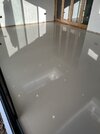Sorry if this question has been posted before - I couldn't find the answer to our particular situation..
Our builder put down self levelling compound over concrete and some pipes. In patches it's not dried after over a week with dark patches and 40% on the moisture meter.
I think under it there was quite a lot of water from the plumbing work [but not everywhere in pictures], and remember seeing some sand then concrete going down first in parts at least. Unfortunately I don't know how long they left each stage to dry, and the house has been cold with no heating in Feb/March. The largest areas I think they might have covered up with boards etc before things were dry; we moved some of their things to find SLC damp underneath.
It's also not very flat - with undulations measuring 8mm vertically in less than 1m horizontal.
We were planning to put engineered wood and kitchen on it next week but not sure if we should delay, or if SLC might need ripping up again or something.. and don't want to risk having to pull the kitchen out again later.
Any advice on what to do would be amazing!




Our builder put down self levelling compound over concrete and some pipes. In patches it's not dried after over a week with dark patches and 40% on the moisture meter.
I think under it there was quite a lot of water from the plumbing work [but not everywhere in pictures], and remember seeing some sand then concrete going down first in parts at least. Unfortunately I don't know how long they left each stage to dry, and the house has been cold with no heating in Feb/March. The largest areas I think they might have covered up with boards etc before things were dry; we moved some of their things to find SLC damp underneath.
It's also not very flat - with undulations measuring 8mm vertically in less than 1m horizontal.
We were planning to put engineered wood and kitchen on it next week but not sure if we should delay, or if SLC might need ripping up again or something.. and don't want to risk having to pull the kitchen out again later.
Any advice on what to do would be amazing!
Last edited:


